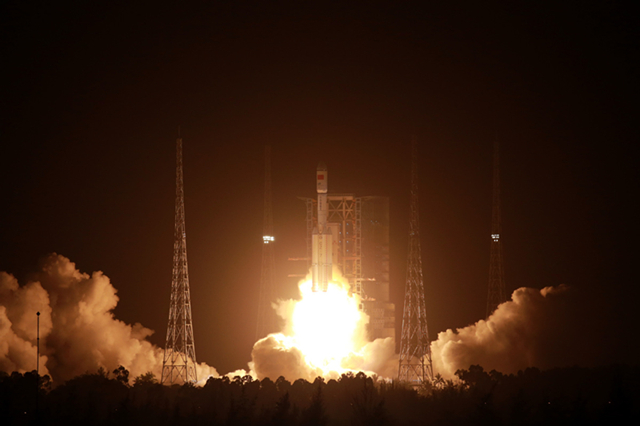
A Long March 7 rocket, carrying the Tianzhou 2 cargo spacecraft, blasts off from the Wenchang Space Launch Center in Hainan province, on May 29, 2021. [Photo by Tu Haichao/for China Daily]
Tianzhou 2, a cargo spacecraft launched on Saturday evening, docked with Tianhe-the recently deployed core module of the country's permanent space station-early on Sunday morning, according to the China Manned Space Agency.
A Long March 7 rocket, carrying Tianzhou 2, blasted off from the Wenchang Space Launch Center on the coast of the southern island province of Hainan at 8:55 pm on Saturday.
After a 10-minute flight atop the 53-meter rocket, the craft entered a low Earth orbit, unfolded its solar panels and began to execute the rapid autonomous rendezvous and docking procedures, which lasted about eight hours, the agency said in a statement.
Tianzhou 2 successfully docked with Tianhe's rear hatch at 5:01 am. Next, it is programmed to conduct autonomous refueling operations and carry out some equipment tests, according to the statement.
When astronauts from the Shenzhou XII spacecraft board Tianhe in the near future, they will gradually move living materials and mission payloads from Tianzhou 2 to the core module.
Tianhe, or Harmony of Heavens, was lifted by a Long March 5B heavy-lift rocket at the Wenchang launch center on April 29. The module, the largest and heaviest spacecraft China has ever built, is the first part of the Chinese space station, named Tiangong, or Heavenly Palace.
Before docking with Tianzhou 2, Tianhe carried out a series of tests to verify its designs for rendezvous and docking maneuvers, astronaut accommodation and experimental equipment.
Hao Chun, director of the manned space agency, said previously that the Shenzhou XII spacecraft, carrying three astronauts, will launch and dock with Tianhe early in June. The crew will stay in the module for three months.
Tianzhou 2's launch was originally scheduled for the early morning of May 20, but mission commanders decided to postpone it shortly before the predetermined ignition time after a technical problem on the rocket was detected.
Over the past 10 days, engineers and technicians from the China Academy of Launch Vehicle Technology, which designed and built the rocket, raced against time to pinpoint and solve the problem and managed to make sure the rocket could be launched on Saturday, according to the academy.